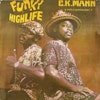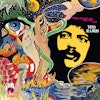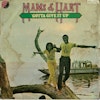It began in Africa. That much seems unassailable, at least when you’re talking about the roots of rhythm-based music. In the early ’70s, however, one mighty American bandleader sent a powerful return volley across the Atlantic that shook the African scene to its core. Even in Ghana, the crucible of highlife, the music of James Brown was an unstoppable force. Soul Brother No. 1 played a massive concert in nearby Lagos in 1970, and his new breed of funk was threatening the very existence of highlife bands, even in the capital Accra.
Adding fuel to the fire was Sierra Leonean guitarist Geraldo Pino. An early adopter of the JB sound, Pino held residencies in Accra and Lagos, and, in the words of no less than Fela Kuti, “had all Nigeria in his pocket.” In this environment, now indifferent if not hostile to highlife, a working band who couldn’t beat ’em had no choice but to join ’em. So began a fertile time for a rough-and-ready crossbreeding of the grooviest strains of music on the planet.
Charles Kofi Mann was no newcomer; he played in the popular ensemble Kakaiku’s No. 1 Guitar Band in the mid-’60s and formed his own Carousel 7 band late in the decade. They recorded for the ubiquitous Essiebons label, which fortuitously had legendary guitarist Ebo Taylor as a house producer. After an early highlife hit, “Edina Brenya,” the Carousel 7 began a conscious effort to incorporate elements of the new sound into their typical highlife arrangements. A strong effort entitled Party Time with Ceekay was followed in 1975 by the group’s most explicit combination yet, Funky Highlife.
The first side of the party-ready record—simply two fifteen-minute medleys—is anchored by a monstrous hybrid groove that must rank as the supreme representative of its mongrel genre. Congas, clave, and shaker in the left channel jostle with a galloping trap set on the right, while muffled handclaps wait their turn in the spotlight. A spellbinding call-and-response vocal section (shouting out the Asafo tribe) builds like water bursting a dam until liquid wah-wah guitar ripples over everything, the handclaps finally stepping well out in front and cracking like celebratory gunshots. When the organ enters with reggae stabs on the offbeat, there is no doubt that highlife has truly gone funky.
Mann’s audacious experiment was a sensation, and is still a favorite—not just among DJs and producers (the Funky Lowlives lifted their name and first record directly from it), but also in Ghana, where Omanhene Pozo, a respected name in the latest cross-cultural genre mix-up, hiplife, recorded an updated version with the assistance of C.K. himself.


